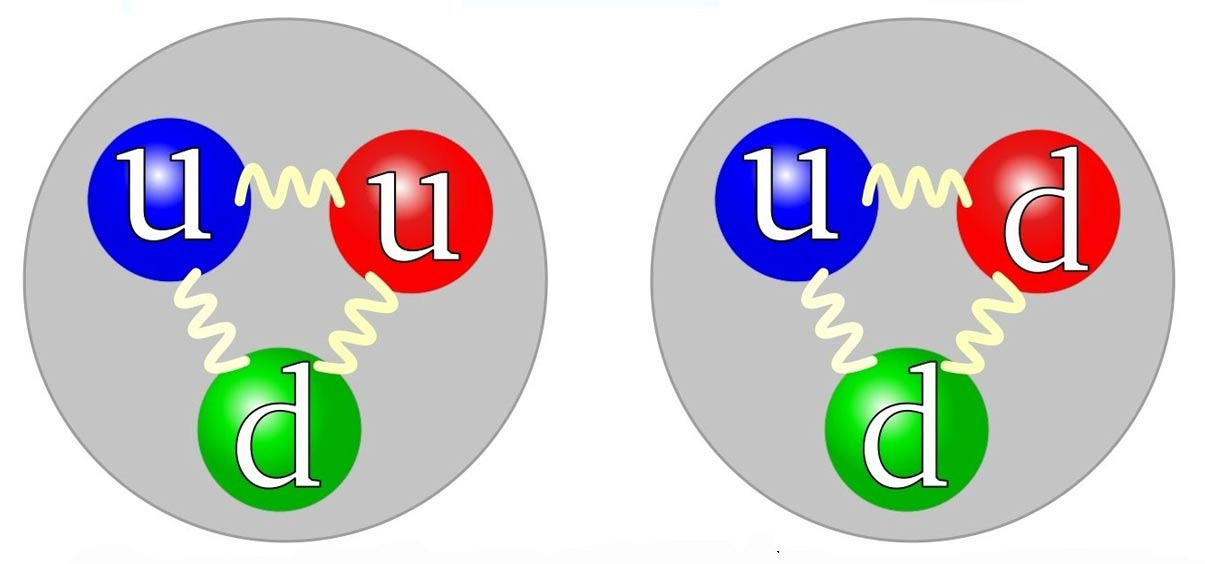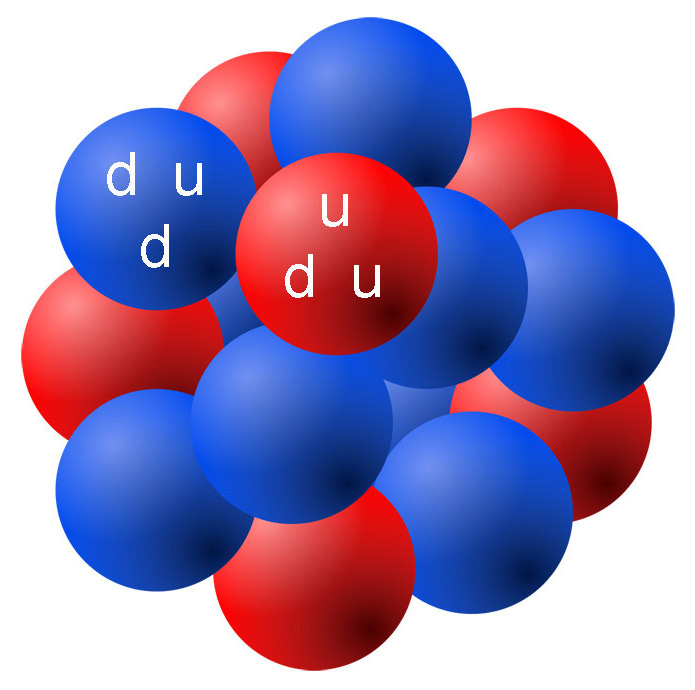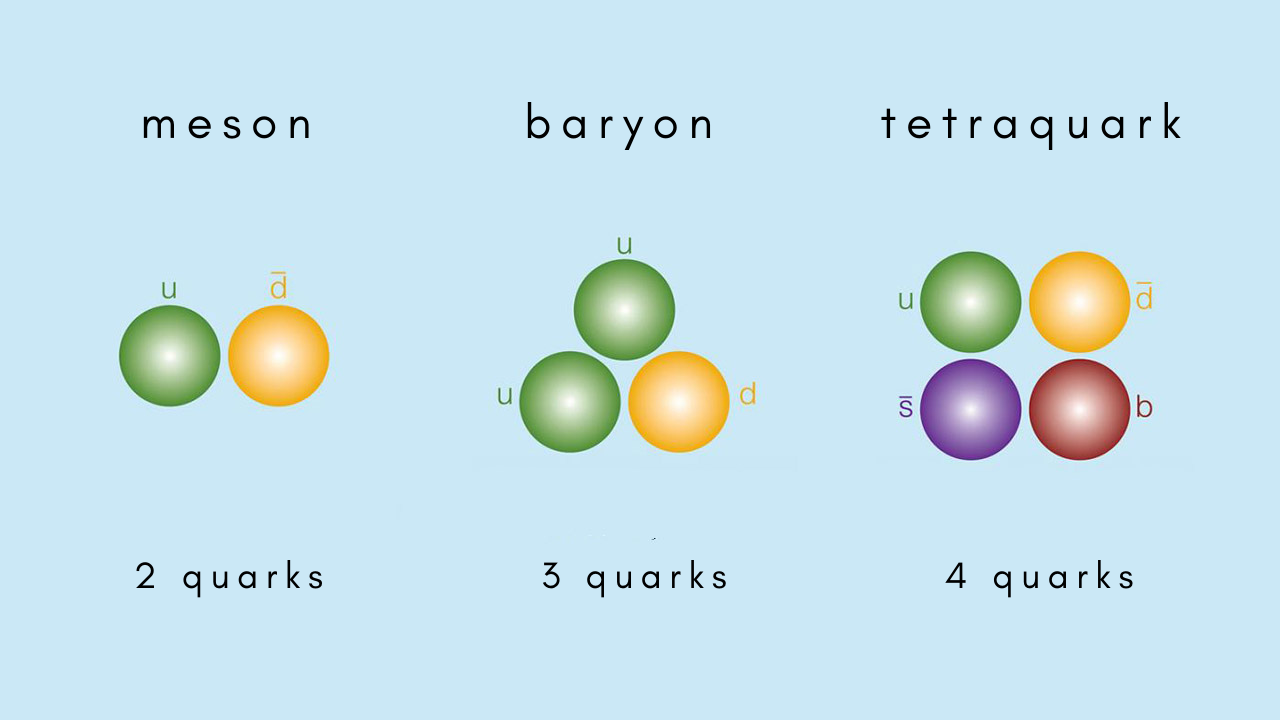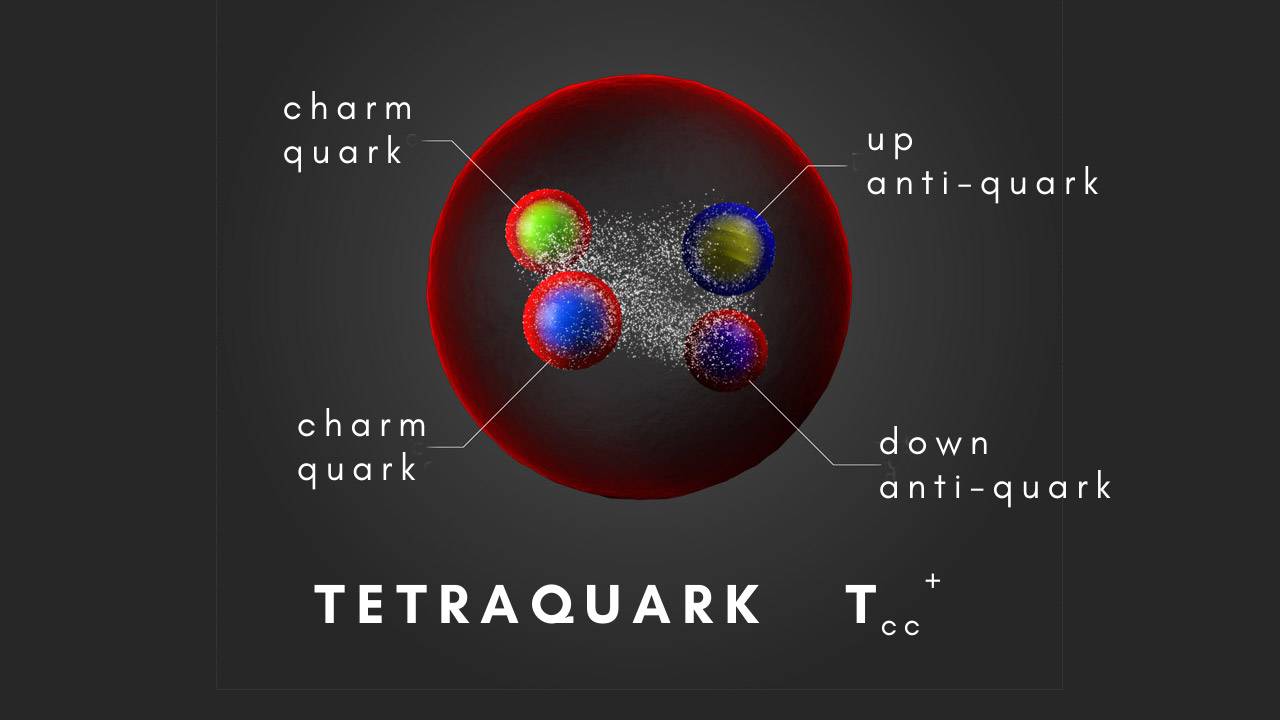quark

Figure 1. A proton (left) is composed of 2 up quarks and 1 down quark, a neutron of 2 down quarks and 1 up quark.

Figure 2. Protons (red) and neutrons (blue), each made of quarks, form the nuclei of atoms.

Figure 3. Quark composition of a meson, a baryon, and a tetraquark.

Figure 4. The Tcc-plus tetraquark.
A quark is a member of one of the two families of fundamental particles – the other is leptons – from which all known matter is made. Quarks are the building blocks of hadrons. They come in six flavors (up, down, strange, charm, top, and bottom) and three colors (red, green, and blue).
Quarks take part in interactions through the strong force. They have an electric charge of either +2/3 (up, charm, and top) or –1/3 (down, strange, and bottom) in units where the charge on the proton is 1. A proton is made of two up quarks (each with an electric charge of +2/3) and one down quark (with a charge of –1/3), while a neutron is made of two downs and one up (Figure 1). Mesons consist of one quark and one antiquark.
Although quarks are believed to have existed in a free state in the first fraction of a second after the Big Bang, it is an open question whether they can still do so anywhere in the universe today. One possibility is inside quark stars.
| Properties of quarks | ||||||
|---|---|---|---|---|---|---|
| generation | weak isospin | flavor | name | symbol | charge | mass |
| 1 | +1/2 | Iz=+1/2 | up | u | +2/3 | 1.5–4.0 |
| 1 | -1/2 | Iz=-1/2 | down | d | -1/3 | 4–8 |
| 2 | -1/2 | S=-1 | strange | s | -1/3 | 80–130 |
| 2 | +1/2 | C=1 | charm | c | +2/3 | 1150–1350 |
| 3 | -1/2 | B'=-1 | bottom | b | -1/3 | 4100–4400 |
| 3 | +1/2 | T=1 | top | t | +2/3 | 170900±1800 |
Short history of quarks
In the 18th century, the Croatian philosopher Roger Boscovich came up with a curiously prescient fundamental theory of matter which described particles not unlike quarks. The modern story of quarks, however, began in 1964, when Murray Gell-Mann and George Zweig suggested that hundreds of the particles known at the time could be explained as combinations of just three fundamental particles. Gell-Mann chose the name "quarks" for these three particles, a nonsense word used by James Joyce in the novel Finnegan's Wake: "Three quarks for Muster Mark!"
In order to make their calculations work, the quarks had to be assigned fractional electrical charges of 2/3 and –1/3. Such charges had never been observed before, so that, initially, quarks were regarded as a mere mathematical contrivance. Subsequent experiments convinced physicists that not only do quarks exist, but there are six of them, not three.
The two lightest quarks are called up and down. The third quark is called strange. It was named after the "strangely" long lifetime of the K particle, the first composite particle found to contain this quark.
The fourth quark type, the charm quark, was named on a whim. It was discovered in 1974 almost simultaneously at both the Stanford Linear Accelerator Center (SLAC) and at Brookhaven National Laboratory. The fifth and sixth quarks were sometimes called truth and beauty in the past, but even physicists thought that was too cute. The bottom quark was first discovered at Fermi National Lab (Fermilab) in 1977, in a composite particle called upsilon. The top quark – the most massive quark – was discovered last, also at Fermilab, in 1995. It had been predicted for a long time but had never been observed successfully until then.
Tetraquarks and the Tcc-plus
Twenty years ago, physicists didn't know of any particle from that contained other than two or three quarks. Then, in 2003, the first tetraquark, made of four quarks, was found (Figure 3) and since then researchers have discovered a number of other tetraquarks and pentaquarks, containing four or five quarks – all as short-lived products in high-energy collision experiments.
Some previously discovered tetraquarks also include charmed quarks. There's one, for instance, that's made up of two charm quarks and two charm antiquarks. In July 2021, however, physicist announced the discovery of the so-called Tcc-plus, which contains two charm quarks plus an up and a down antiquark.
The Tcc-plus (Figure 4) is the first known tetraquark to contain two charm quarks without any charm antiquarks to balance them. Particles that have the same number of charm quarks and antiquarks have what physicists call "hidden charm"—the charm quantum number for the whole particle adds up to zero, just like a positive and a negative electrical charge would do. The new particle is said to have "open charm" – in fact, double open charm. It also has other interesting features. It's the first tetraquark to be found that has two heavy quarks and two light antiquarks. Such particles decay into a pair of mesons, each formed by one of the heavy quarks and one of the light antiquarks. According to some theoretical predictions, the mass of this kind of tetraquark should be very close to the sum of the masses of the two mesons into which it decays – a fact that should make the decay more difficult. And, indeed, the Tcc-plus is the longest-lived exotic hadron found to date.
The discovery will encourage physicists to look for heavier particles of the same type, with one or two charm quarks replaced by bottom quarks. The particle with two bottom quarks is especially interesting because calculations suggest that its mass should be less than the sum of the masses of any pair of B mesons. This would make the decay not only unlikely, but actually impossible: the particle wouldn't be able to decay via the strong force. It could only decay by way of the weak force, which would make its lifetime several orders of magnitude longer than any previously observed exotic hadron. Researchers will also want to learn more about the new tetraquark itself. The particles into which it decays are all fairly easy to detect, so that it ought to be possible to the measure the mass and other properties of the Tcc-plus with good precision. This information will be valuable in testing rival theoretical models of the subatomic world and perhaps even opening a window on physics beyond the Standard Model.
Squark
The squark is the hypothetical spin-zero supersymmetry partner, or superpartner, of the quark.

